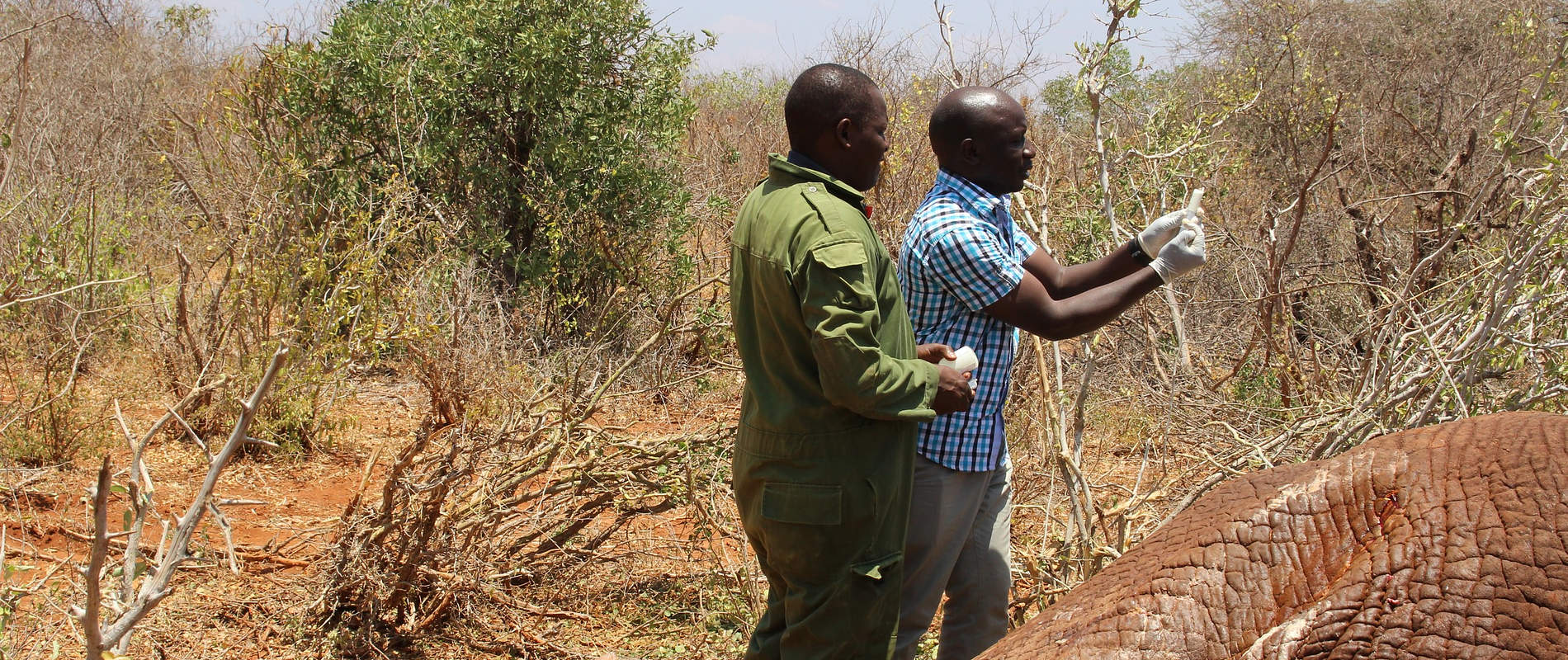VETERINARY REPORT FOR TSAVO MOBILE VET UNIT FOR THE MONTH OF FEBRUARY 18 Reported by Dr Jeremiah Poghon Introduction The month of February returned mixed fortunes for the Tsavo conservation area with vegetation drying up fast but still with plenty of water at the temporary water holes around the region
VETERINARY REPORT FOR TSAVO MOBILE VET UNIT FOR THE MONTH OF FEBRUARY 18
Reported by Dr Jeremiah Poghon
Introduction
The month of February returned mixed fortunes for the Tsavo conservation area with vegetation drying up fast but still with plenty of water at the temporary water holes around the region. Cases attended were treatment of an elephant orphan attacked by a lion near Ithumba DSWT stockades, an Elephant calf with a fractured femur near Voi River, Tsavo East, a majestic elephant bull with 2 spear wounds at Kimana sanctuary in Amboseli and sudden death in a Zebra investigated near Severin camp, Tsavo West to name but a few.
CASE#1 TREATMENT OF AN DSWT EX-ORPHAN ELEPHANT
Date: 1st February 2017
Species: Loxodanta Africana (African Elephant)
Sex: Male
Age: Sub- adult
Location: Ithumba, Tsavo East
History
This young elephant, a former DSWT orphan, was attacked by a lion while foraging near Ithumba Park Headquarters with other former orphans. He was saved by one of the other older orphans and then his herd lead him back to the stockade for safety where the keepers reported the injury.
Immobilization, examination and treatment
The Vet was airlifted to Ithumba by DSWT aeroplane and found the injured elephant in one of the stockades.. A dart consisting of 7mgs Etorphine was prepared and loaded into a Dan inject dart rifle. The Elephant was approached and darted from foot and went down after 5 minutes. There were puncture wounds all over the body inflicted by a lion and a serious laceration on the right knee joint with damage to muscle insertions and ligaments. The wound was washed clean using normal saline mixed with antibiotics then doused with tincture of iodine. Green clay was used to cover the wound. An intravenous administration of dexamethasone Hcl was given through the ear vein while Enrofloxacin was administered intravenously.
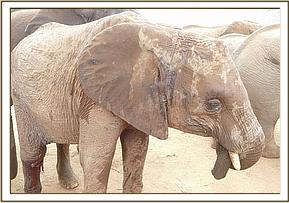

Reversal and Prognosis
The anaesthesia reversed by administration of Diprenorphine at 3 times the Etorphine dose. Prognosis is guarded due to severe tissue damage to the limb.
CASE#2 TREATMENT OF AN ELEPHANT CALF
Date: 4th February 2018
Species: Loxodanta Africana (African Elephant)
Sex: Female
Age: 4 years old
Location: Voi River, Tsavo East
History
A report was received from the tourists regarding an injured elephant calf within Tsavo East National Park near Voi River. They reported that the calf was unable to walk. The team rushed to the area to find the calf and the mother under a tree along the river. Physical examination indicated a complete fracture due to carrying leg lameness.


Immobilization and management
The elephant calf was darted from foot using 6mg of Etorphine in a dan-inject dart fired from a Dan-Inject rifle. The mother was chased away and she went down after a few minutes. Close examination revealed complete fracture of the right femoral bone. With very poor prognosis the calf was euthanized due to animal welfare grounds.
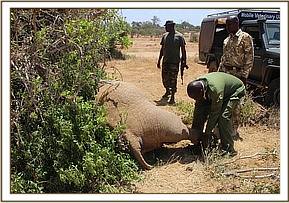

CASE#3 TREATMENT OF AN ELEPHANT BULL
Date: 7th February 2018
Species: Loxodanta Africana (African Elephant)
Sex: Male
Age: Adult
Location: Ithumba, Tsavo East
History
A report was received from Ithumba DSWT staff regarding an injured elephant bull with an injury to the left abdominal area. The Vet was airlifted by DSWT Helicopter and found the bull near the stockade under a tree.
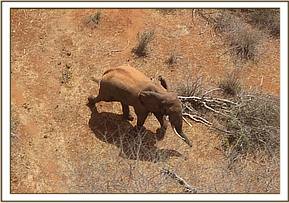

Immobilization, examination and treatment
The elephant was easily darted from the helicopter using 18mgs Etorphine in a 3 ml Dan - inject dart. After it was successfully darted, the helicopter followed the elephant from a distance until he went down on sterna recumbency after 8 minutes. The sitting position posed a threat as the elephant cannot breathe well. The helicopter landed and the team rushed in and pushed him into a lateral position but unfortunately he fell on the injured flank. A tractor was called in to assist with flipping the elephant over.


There was a deep penetrating wound to the upper abdominal area with pus oozing out. A drainage incision was made at the lowest point to drain out pus. The wound was then washed with water mixed with Hydrogen peroxide. Necrotic tissues and pus were removed then the wound doused with tincture of iodine. Green clay was used to cover the wound. Long acting antibiotics were administered IM and Dexamethasone Hcl given via IV through the ear. Cause of injury is an arrow shot.
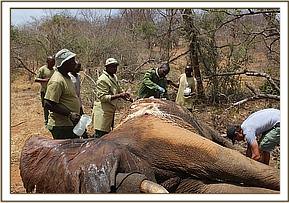

Reversal and Prognosis
Anaesthesia was reversed using Diprenorphine at 3 times the Etorphine dose and the elephant stood up and walked away. Prognosis is good.
CASE #4 TREATMENT OF AN ELEPHANT BULL
Date: 8th February 2018
Species: Loxodanta Africana (African Elephant)
Sex: Male
Age: Adult
Location: Kimana sanctuary, Amboseli National Park.
History
A report was received from Big Life Rangers about an injured elephant bull within Kimana Sanctuary near Amboseli National Park. They reported it had a spear wound to the right rump area and another higher up the flank. The Vet was airlifted to Amboseli by DSWT aeroplane and found big life and KWS teams watching over the injured elephant.


Immobilization, examination and treatment
The vet prepared a dart containing 18mgs Etorphine and then darted the elephant from a vehicle using a Dan-inject® dart rifle. It was immobilized after 6 minutes and fell on its flank.
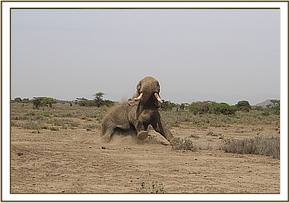

The two spear wounds were cleaned with Hydrogen peroxide mixed with water, doused with tincture of iodine and sprayed using Oxytetracycline spray. A final cover of green clay was administered. Another wound to the right front limb was also cleaned and green clay applied. Intravenous administration of Dexamethasone Hcl was given through the ear vein and long acting Amoxicillin by intramascular route.
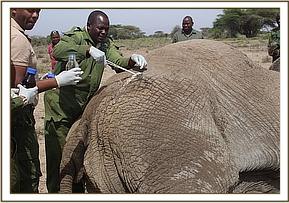



Reversal and Prognosis
Anaesthesia was reversed by administration of Diprenorphine Hcl at three times the Etorphine dosage. Prognosis is good.
CASE#5 AUTOPSY EXAMINATION OF A ZEBRA CARCASS
Date: 9th February 2017
Species: Zebra
Sex: Female
Age: Adult
Location: Severin Camp, Tsavo West
History
The senior warden of Tsavo West National Park reported the sudden death of a zebra near Kitani Severin camp that morning. The team rushed to the area to find the bloated haemorrhaging carcass nearby.
Autopsy examination
The carcass was lying on its flank with blood oozing from the nostrils, mouth and vaginal and anal openings. The blood wasnt clotting and there was evident bloating of the carcass. The area was dry with little forage left.


The signs observed are pathognomic for Anthrax infection and proper care was taken to prevent personell infection. Gloves were worn and blood sample taken from the jugular vein. The carcass was disposed off by burrying deep in the ground and the ground desinfected using 10% formalin.
Slides stained using Giemsa stain returned positive rodes for Anthrax.
CASE#6 TREATMENT OF A SNARED ELEPHANT COW
Date: 16th February 2018
Species: Loxodanta Africana (African Elephant)
Sex: Female
Age: Adult
Location: Sala gate, Tsavo East.
History
This elephant cow was first reported by DSWT de-snaring team who were patrolling the area and alerted the Kaluku HQ. The Vet team was collected from Komboyo airstrip and airlifted by DSWT chopper to Sala gate area of Tsavo East where we found the team monitoring the herd with the snared elephant.
Immobilization, examination and treatment
A dart was prepared and loaded with 16mgs of Etorphine after which the cow was darted from a chopper. She was immobilized in 6 minutes.
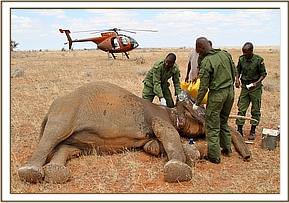
A tight deeply cutting wire snare around the neck was cut loose. Pus, dirt debris and necrotic tissues were removed and the wound cleaned using Hydrogen peroxide mixed with water, then doused with tincture of iodine and sprayed with Oxytetracycline spray. Wetted green clay was applied to aid in wound healing and to keep dirt and flies out of the wound. Long acting antibiotics and Dexamethasone Hcl were administered parenterally.
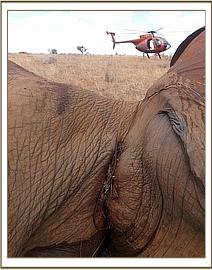

Reversal and Prognosis
Anaesthesia was reversed using Diprenorphine at 3 times the Etorphine dose. It has been given a good prognosis.
CASE#7 TREATMENT OF A LAME ELEPHANT BULL
Date: 19th February 2018
Species: Loxodanta Africana (African Elephant)
Sex: Male
Age: Adult
Location: Komboyo, Tsavo West
History
This elephant bull was reported by KWS research staff as they were escorting guests in the area. They alerted the vet team who rushed to the area to find the bull had moved away from the water hole. The bull was traced and found nearby.
Immobilization, examinatino and treatment
A dart was prepared and loaded with 18mgs of Etorphine after which the bull was darted from a vehicle. He was immobilized in 6 minutes. The right knee was swollen with no obvious external injury. The knee joint injury was thought to have been caused by natural causes.

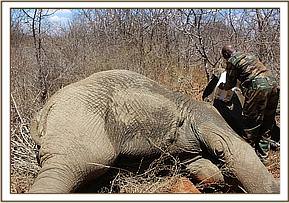
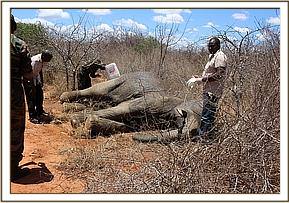

Flunixine meglumine Hcl were administered parenterally to ease the pain and swelling.
Reversal and Prognosis
Anaesthesia was reversed using Diprenorphine at three times the Etorphine dose. Prognosis is good.
CASE#8 SNARED HIPPO
Date: 19th February 2018
Species: Hippopotamus
Sex: Male
Age: Adult
Location: Sabaki River, Malindi
History
This snared Hippo was reported by KWS personnel from Malindi station. It had a tight tissue cutting wire around the neck that had cut through skin, the fat layer and some neck muscles. The Hippo posed a great challenge as it was difficult to locate and there were risks of drowning after immobilization. A team comprising of the Vet Unit, locals, KWS rangers from Malindi station and Honorary Wardens managed to trace the hippo on the 19th February 2018. It was found deep inside the river and assessment of the injury gave it poor prognosis due to the difficulty of darting, retrieving from the river and prospects of the wound healing in case of success in the earlier mentioned intervention steps. A decision was made to euthanize the Hippo on animal welfare grounds.


CASE#9 TREATMENT OF A LAME ELEPHANT CALF
Date: 21th February 2018
Species: Loxodanta Africana (African Elephant)
Sex: Male
Age: 5 years old
Location: Teita sisal estate, Mwatate
History
The Teita Sisal staff manning the Conservancy alerted the vet team to a lame elephant calf. The Vet team rushed to the area to find the young bull under a tree.
Immobilization, examination and treatment
The calf was immobilised using 6 mgs of Etorphine in a dan-inject dart. The vet darted the calf from a vehicle and he was immobilized in 5 minutes. The left front knee was swollen with no obvious external injury. The lameness was most likely caused by a joint dislocation. Flunixine meglumine Hcl were administered parenterally to ease the pain and swelling.


Reversal and Prognosis
Anaesthesia was reversed using Diprenorphine at three times the Etorphine dose. The young age of the elephant gives it a better prognosis.
CASE#10 TREATMENT OF AN ELEPHANT BULL
Date: 23rd February 2018
Species: Loxodanta Africana (African Elephant)
Sex: Male
Age: Adult
Location: Manyani, Tsavo East
History
A Report was received from KWS Manyani gate staff regarding an injured elephant bull with a huge swelling on the right rear leg that had pus oozing out. The Vet team drove to the area and found the bull with his partner nearby.
Immobilization, examination and treatment
The elephant was darted with 18mg Etorphine from a vehicle using a Dan-Inject rifle. He was then followed from a distance until he went down on sternal recumbency after 9 minutes. He was pushed to lateral recumbency which revealed a penetrating wound to the upper thigh area near the lumbo-sacral area with huge accumulation of pus stretching down to the knee joint area.


The lowest point of the wound was cut open and large amounts of pus drained out. Chunks of necrotic tissues and an arrow head were then removed from the wound after which the wound was washed clean using water mixed with Hydrogen peroxide and tincture of Iodine. Green clay was used to cover the wound and long acting antibiotics were administered IM as well as Dexamethasone Hcl via IV through the ear.

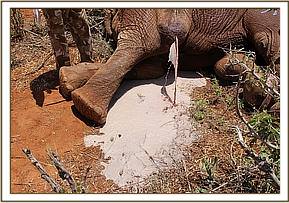


Reversal and Prognosis
The anaesthesia was reversed using Diprenorphine at 3 times the Etorphine dose and the elephant stood up and walked away. Prognosis is good.
Other activities undertaken
The unit examined several wildlife trophies/parts and produced expert reports to aid in prosecution of the offenders in court and testified in Malindi court on the same.
Acknowledgement
The unit acknowledges the support of its sponsors ViER PFOTEN through the David Sheldrick Wildlife Trust (DSWT) for their immense financial contribution to the unit. We also thank Kenya Wildlife Service through the Assistant Director Tsavo Conservation Area and the Head, Veterinary and Capture services department for their support.
